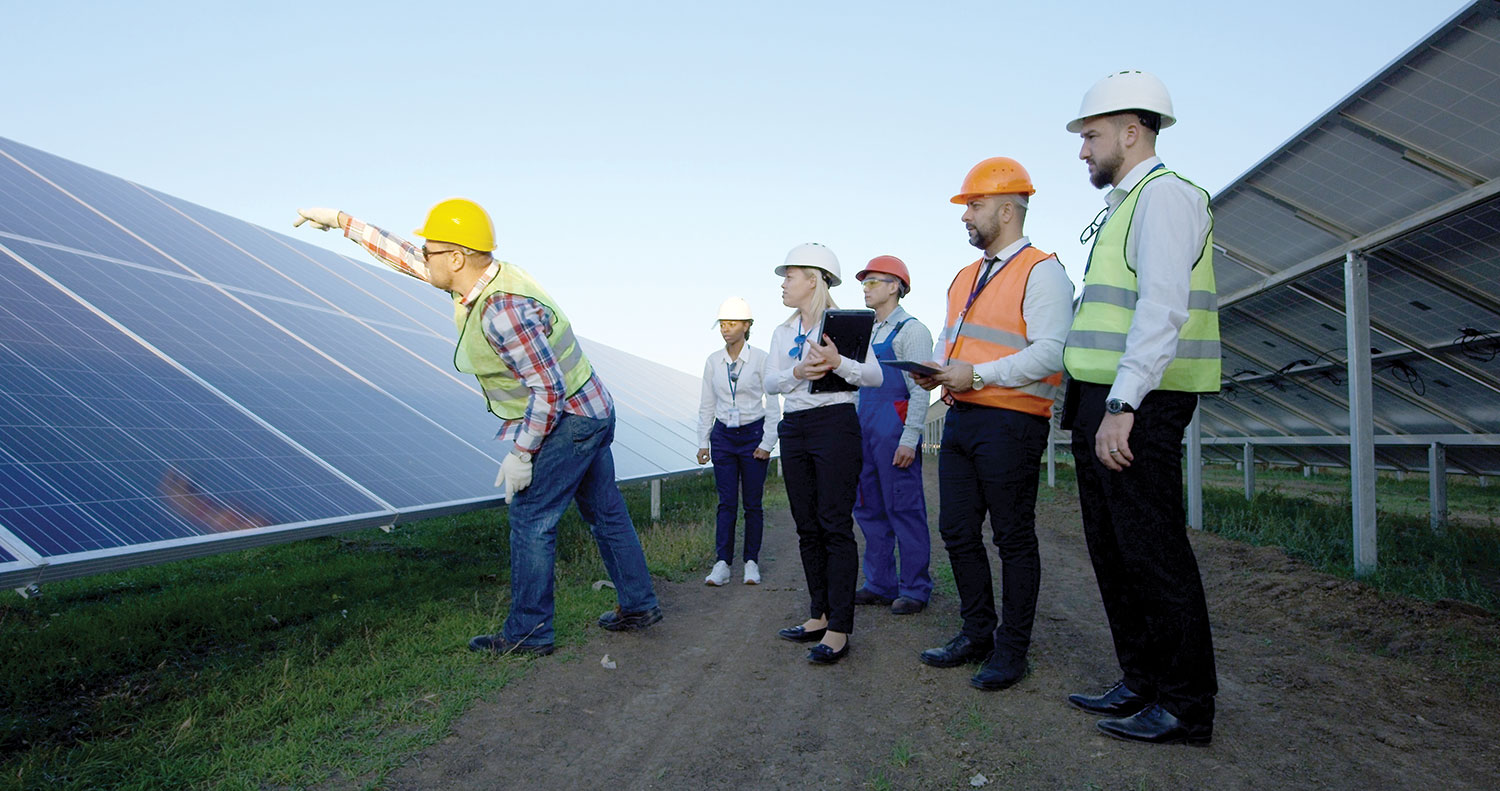Rule 217A2 requires readily climbable supporting structures to be equipped with barriers to inhibit climbing by unqualified persons. The old rule had an exception that said that this rule does not apply when the right-of-way is fenced. Since there was no requirement for the fence, a split rail fence would satisfy the rule. The new exception says, “The rule does not apply where access to the supporting structure is limited by a fence meeting the height requirement of Rule 110A.” The fence must now be seven feet tall and limit access to the structure. If a seven-foot-tall fence does not limit access, then the fence doesn’t meet the requirements of the rule. A fence meeting all the requirements of Rule 110A will certainly limit access.
Old Rule 231B1 required supporting structures and equipment attached thereto to be located 6″ behind the curb of a roadway. The revised rule also requires anchor guys to be located 6″ behind “re-directional curbs” and “for paved or swale-type curbs, such facilities shall be located behind the curb.”
Rule 232B4a now specifies minimum ground clearance of street and area lighting luminaries. The clearance shall not be less than that shown in Table 232-2. For this purpose, grounded luminaire cases and brackets shall be considered rigid live parts of the voltage contained. There is an exception stating that “This rule does not apply to post-top mounted luminaries with grounded or entirely dielectric cases.”
Table 232-1 footnote 13 applies to the ground clearance of conductors passing over driveways, parking lots, and alleys. The revised footnote 13 allows reduced clearance for driveways, parking lots, and alleys not subject to truck traffic.
Table 232-1 new footnote 18 applies to clearance of conductors over water. The new footnote takes on the wording of part of old footnote 17 defining clearance based on the “normal flood level” with an important addition “if available, the 10-year flood level may be assumed as normal flood level.”
Table 232-1 new footnote 26 applies to the ground clearance of conductors passing over land traversed by oversized vehicles such as farm vehicles used for cultivation and harvesting. The new footnote states that “When designing a line to accommodate oversized vehicles, these clearance values shall be increased by the difference between the known height of the oversized vehicle and 14 ft.”
Table 232-2 now covers the vertical clearance of support arms, platforms, and braces in addition to equipment cases and unguarded rigid live parts.
Table 232-2 used to require effectively grounded equipment cases located within the limits of a highway right-of-way to be 15 ft. above ground. The revision applies footnote 7 to this category so that now these cases “may be mounted at lower level for accessibility, provided such cases do not unduly obstruct a walkway.”
Rule 233 defines the clearance between conductors and cables carried on different supporting structures based upon various conductor temperatures, sag, ice and wind loading information. The wind displacement of the conductor is calculated based on a wind pressure of 6 lb./sq.ft. The old rule allowed wind loading to be “reduced to 4 lb./sq.ft. in areas sheltered by buildings, terrain, or other obstacles.” Some people assumed that lines constructed through forests were suitably sheltered. The new wording better defines the conditions under which the reduction may be made. “Where the entire span is close to a building, terrain feature, or other obstacle as to be sheltered from the wind flowing across the line in either direction, the wind force may be reduced to 4 lb./sq.ft. Trees are not considered to shelter a line.”
Rule 234A2 specifies the horizontal clearance of conductors from buildings, bridges, and rail cars based upon wind displacement. The same conditions for reduction to 4 lb./sq. ft. as discussed in Rule 233 (above) applies here.
The old Rule 234C3a defined the types of conductors suitable for service drops of 0 to 750 volts. The revised rule now also covers service drops over 750 volts.
Rule 234C3d(1) now also covers vertical clearance over roofs and balconies of service drops above 750 volts.
Table 234-1 category 2a covers clearances of conductors to signs, chimneys, billboards, radio and television antennas, tanks, and other installations not classified as buildings or bridges. The revision now specifies different horizontal clearances for portions that are readily accessible to pedestrians and portions that are not readily accessible to pedestrians.
New Rule 235H requires minimum 12″ spacing at the pole between messengers supporting communications conductors and 4″ clearance anywhere in the span between conductors, cables and equipment of one communications utility to those of another “except by agreement between the parties involved.”
New Rule 235I covers “Clearances in any direction from supply line conductors to communication antennas in the supply space attached to the same supporting structure.” This rule covers for example the installation of cell phone antennas in the supply space.
New Rule 239A6 states that when the code requires guarding or protection of vertical conductors, “…either conduit or U-guard may be used. A backing plate shall be used with a U-guard unless the U-guard fits tightly to the supporting structure surface.” Given the typical spacing of lag screws used to hold U-guard to poles and the typical irregular surfaces of wood poles, backing plates are now required.
Strength and Loading
New Rule 250A states that “The structural capacity provided by meeting the loading and strength requirements of Sections 25 and 26 provide sufficient capability to resist earthquake ground motions.”
Rule 250C covering extreme wind loading has been greatly changed. The equation used for calculating the wind’s force now has three additional factors, Velocity Pressure Exposure Coefficient, Gust Response Factor and Importance Factor. Figure 250-2 (the map), from whence we acquire the basic wind speed, has been changed. The wind speeds are now nominal design 3-second gusts, which are much higher than the old values. I will get into the details of these changes in a future article.
New Rule 261A2f requires “All structures including those below 60 ft. shall be designed to withstand, without conductors, the extreme wind load in Rule 250C applied in any direction on the structure.” This was previously only required of metal, prestressed, and reinforced-concrete structures in Rule 261A1c.
Rule 261D4c which covers the strength requirements of double crossarms and brackets for Grade B construction, now requires each arm used in double crossarm construction to have the strength required by Rule 261D2a.
Table 261-1A and 261-1B cover “strength factors of structures, crossarms, support hardware, guys, foundations, and anchors…” Two paragraphs have been added to both tables to clarify the strength requirements of deteriorated structures as spelled out in footnotes 2 and 3 of Table 261-1A. I.e. When do you have to replace the pole?
Part 3 (Rules for the Installation and Maintenance of Underground Electric Supply and Communication Lines)
Rule 313A5 now requires line and equipment recorded defects to be “promptly” repaired, disconnected, or isolated when they endanger life or property.
New Rule 323C5 requires “Any manholes greater than 4 ft in depth shall be designed so it can be entered by means of a ladder or other suitable climbing device. Equipment cable, and hangers are not suitable climbing devices.”
Rule 323E2 now requires a prominent safety sign posted where visible before entering a vault or utility tunnel containing exposed live parts.
New Rule 350H states that “The rules in this section” (Section 350 covering Direct Buried Cable) “also apply to direct buried supply and communication cables installed in duct that is not part of a conduit system.” See definition of “”conduit system”” in Section 2.
Rule 351A now requires cables installed parallel to and directly above or under other subsurface structures to comply with the separation requirements in Rules 353 and 354.
Rule 354A2 now requires a radial separation of 12″ between supply or communications cables or conductors and steam lines, gas, and other fuel lines. The installations shall also meet the requirements of Rule 352. The present rules allow separation less than 12″.
The exception under Table 352-1 (old Table 353-1) now only allows reduced burial depth of lighting cables “Where conflict with other underground facilities exist.”
New Rule 380D requires pad-mounted equipment, pedestals, and other above ground enclosures to be located not less than 4 ft. from fire hydrants.
Part 4 (Rules for the Operation of Electric Supply and Communications Lines and Equipment)
Rule 410A covering employer training responsibilities, has been expanded. “The training shall include applicable work rules required by this Part and other mandatory referenced standards or rules. The employer shall ensure that each employee has demonstrated proficiency in required tasks. The employer shall provide retraining for any employee who as a result of routine observation of work practices is not following work rules.”
New Rule 423C4 has been added to cover the use of a torch or open flame in proximity to a visibly exposed gas or other fuel line. Adequate air space or a barrier shall be provided.
New Rule 423D5 has been added to require shoring, sloping, or shielding methods in a trench or excavation where cave-in hazard exists or the trench is in excess of 5 ft. in depth in which workers are required to perform tasks.
Rule 431A covering communications employee approach to energized conductors has been expanded. “When repairing storm damage to communication lines that are joint use with electric supply lines at that or another point, employees shall: 1. Treat all such supply and communication lines as energized to the highest voltage to which they are exposed, or 2. Assure that the supply lines involved are de-energized and grounded in accordance with Section 44.”
Rule 441A3b now specifies what class gloves shall be worn whenever employees are in the vicinity of energized conductors or parts. The gloves shall be insulated for the maximum use voltage as listed in new Table 441-6. The maximum use voltage is detailed in footnote 1 of Table 441-6, phase-to-ground voltage for single-phase circuits and phase-to-phase voltage for multiphase circuits. There are also two exceptions.
National Electrical Safety Code and NESC are registered trademarks of the Institute of Electrical and Electronic Engineers (IEEE).










Find Us on Socials